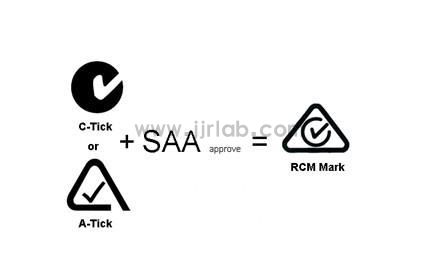
Australia RCM certification process and requirements
rcm certification Steps
1. A third-party laboratory evaluates the product and determines the applicable test standards.
2. If non-compliance is found during testing, the laboratory will arrange for product rectification to meet Australian standards.
3. Once testing is passed, a test report is issued.
4. The test report is submitted to the Australian issuing authority for document review.
5. Upon successfUL review, the rcm certificate is issued.
6. The customer may register on the Australian website themselves, or our company can complete the registration on their behalf.

Key Points for RCM Certification
1. Products must uniformly display the rcm logo; this requirement was announced by Australia on April 19, 2013.
2. For direct plug-in adapters undergoing RCM safety certification, random plug testing is required.
3. For tube lighting products, fluorescent tubes pose higher safety risks because users can directly replace them. Samples must be sent to Australia for evaluation.
4. Processing time varies depending on the issuing authority.
RCM Certification Support Services
1. New RCM applications
2. Certificate renewal
3. Technical modifications to certificates
4. Administrative modifications to certificates
5. Certificate transfer to another holder
6. Certificate extension within the validity period
7. Additional certificate printing services
RCM = Safety + EMC + Importer Declaration
1. Safety (Product Safety Certification)
Safety certification consists of two categories:
- Prescribed Products (Regulated electrical products)
- Non-prescribed Products (Unregulated electrical products)
a) Prescribed Electrical Products
Classified under AS/NZS 4417.2, including electrical heating equipment, refrigeration equipment, power tools, and components.
Three issuing states are most active in certification: Queensland, New South Wales, and Victoria.
Prescribed products mustobtain a Certificate of Approvalfrom the regulatory authority and bear a marking with the certificate number.
The first letter of the certificate number indicates the issuing state or territory:
- Q04051 — Queensland (Q Number)
- W2015 — Western Australia (W Number)
- V03101 — Victoria (ESV Certificate V Number)
- NSW18099 — New South Wales (DOFT Certificate NSW Number)
b) Non-prescribed Electrical Products
No mandatory certification is required for sales, but manufacturers must ensure compliance with AS/NZS 3820:1998 (Essential Safety Requirements for Low Voltage Electrical Equipment).
Compliant products may receive a Certificate of Suitability, and the number’s suffix shows the issuing state:
- CS/431/Q — Queensland
- CS/108/NSW — New South Wales
2. EMC (Electromagnetic Compatibility)
Australia’s emc compliance scheme is based on the Radiocommunications Act 1992. It covers a wide range of products, including:
- Electrically driven or heated appliances
- Power tools
- Lighting and similar devices
- Television receivers and audio equipment
- IT products
- Industrial, scientific, and medical instruments
- Ignition engines and arc welding equipment
Products are classified by their level of potential electromagnetic interference:
Class 1:
Minimal effect on devices using the radio spectrum (e.g., manual switches, simple relays, brushless squirrel cage induction motors, AC power transformers, resistors).
Use of the C-Tick mark is voluntary.
Class 2:
Moderate effect on devices using the radio spectrum (e.g., microprocessor-controlled devices, slip-ring motors, arc welders, switch-mode power supplies, dimmers, motor speed controllers, IT & telecommunications terminal equipment).
Class 3:
Serious effect on devices using the radio spectrum (e.g., Group 2 industrial, scientific, and medical equipment under CISPR 11).
RCM Application Notes
1. If the product already has a cb certificate with national differences addressed, it can be directly converted to a Safety Certificate. Adding the EMC component allows the agent to issue a declaration, and the product can be sold in Australia with the rcm mark.
2. Safety Certificate:For direct plug-in products, an AU plug test (AS/NZS 3112:2004) is required. Desktop-type products do not require this test.
3. EMC Report:Can be a C-Tick report (AS/NZS CISPR 22:2002) or a ce emc report.
RCM (SAA) Issuing Authorities
CB member laboratories conduct testing and submit reports to state certification authorities.
There are 7 authorities (including New Zealand) eligible to process certification:
1. Department of Fair Trading, New South Wales (NSW)
2. Department of Mines and Energy, Queensland
3. The Office of the Chief Electrical Inspector, Victoria
4. Office of Energy Policy, South Australia
5. Office of Energy, Western Australia
6. Office of Electricity, Standards and Safety, Tasmania
7. Ministry of Commerce, New Zealand
Email:hello@jjrlab.com
Write your message here and send it to us
 LED Lighting EMC Testing Service
LED Lighting EMC Testing Service
 EU REACH Compliance Testing Services
EU REACH Compliance Testing Services
 Electronic and Electrical Reliability Testing Serv
Electronic and Electrical Reliability Testing Serv
 Electronic & Electrical Safety Compliance Test
Electronic & Electrical Safety Compliance Test
 Shenzhen Electronic Electromagnetic Compatibility
Shenzhen Electronic Electromagnetic Compatibility
 How to Test IP68 Rating
How to Test IP68 Rating
 Differences Between FDA and LFGB for Food Contact
Differences Between FDA and LFGB for Food Contact
 Process and Precautions for Amazon CPC Certificate
Process and Precautions for Amazon CPC Certificate
Leave us a message
24-hour online customer service at any time to respond, so that you worry!




